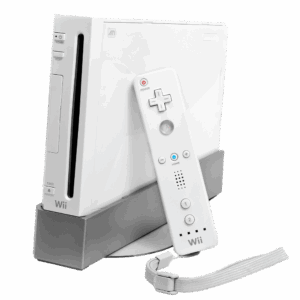
The Wii was a seventh-generation home video game console released by Nintendo in 2006. In contrast to its rivals, the PlayStation 3 and Xbox 360, which competed on processing power, the Wii focused on innovative motion-sensing controls and accessibility to attract a broader audience of both gamers and non-gamers. Its strategy proved highly successful, making the Wii a global social phenomenon.
Innovative features
The Wii was defined by its unique approach to gaming.
- Wii Remote: The primary controller, also known as the “Wiimote,” was a wireless, motion-sensing wand. It used a combination of accelerometers and an infrared sensor bar to track the player’s movements in a three-dimensional space.
- Nunchuk: This was an accessory that connected to the Wii Remote and added an analog stick and extra buttons for more traditional controls in supported games.
- Wii Sports: Included in most bundles outside of Japan, this game package was a “killer app” that demonstrated the motion-control capabilities through simple sports simulations like tennis, bowling, and baseball. It was incredibly successful, selling over 82 million copies.
- Wii Channels: The console’s main menu was organized into “channels” that offered various applications beyond just gaming, including a photo channel, news channel, and weather channel.
- WiiConnect24: This feature allowed the console to stay connected to the internet in a low-power mode to receive messages and updates.
Marketing and success
The
Wii’s unique appeal and lower price point made it a market leader of its generation.
- Broad appeal: Nintendo successfully marketed the Wii to families and casual players who were intimidated by more complex games and controllers. It became common to see people of all ages—including grandparents—playing Wii Sports and Wii Fit.
- Lower price: By focusing on a unique interface rather than high-end graphics and processing power, Nintendo was able to produce the Wii for less money. It launched at $249.99 in North America, making it significantly cheaper than the PS3 and Xbox 360.
- Sales dominance: This strategy resulted in enormous commercial success. The Wii became the best-selling console of the seventh generation, selling over 101 million units worldwide.
Technical specifications
While the Wii’s main selling point was its motion controls, its technical features were more modest compared to its rivals.
- CPU: IBM “Broadway” PowerPC-based processor running at 729 MHz.
- GPU: ATI “Hollywood” graphics processor running at 243 MHz.
- Storage: 512 MB of internal flash memory, which could be expanded via SD card.
- Backwards compatibility: The original model was backwards-compatible with Nintendo GameCube games, controllers, and memory cards, though later revisions removed this feature.